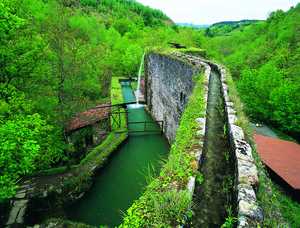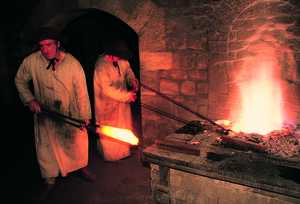gipuzkoakultura.net





During the first half of the seventeenth century, López de Isasti tallied 118 operating forges-80 'greater' and 38 'lesser'. By the mid eighteenth century the number had fallen to 58 while one hundred years later, only four survived. Their resistance to change was the main cause of their decline and progressive closure. Competition from blast furnaces-a well-established technology in Central Europe and Great Britain-and the introduction of Swedish steel onto the market, highlighted the non-competitiveness of the old Cantabrian ferrerías.
Inevitably, after they were abandoned, the works fell into disrepair and eventually disappeared, but there are still many traces of this important activity to be found throughout the province. Indeed, an inventory drawn up during the 1990s by the Basque Government, indicated 62 sites with significant remains of forges in Gipuzkoa, as compared to 60 in Bizkaia and just 9 in Alava, though most of the buildings are now in ruins.
An exceptional case is the Agorregi iron and grain mill complex in Aia, where thanks to rebuilding work funded by the Provincial Government, we can now see first-hand one of the most striking examples of hydraulic engineering placed at the service of traditional industry in the country. Although there is documentary evidence of activity here in the sixteenth century, the present complex dates from 1754 when its owner, Joaquín de Lardizabal, commissioned new plans from Francisco de Ibero. This Gipuzkoan engineer designed an ingenious arrangement to make maximum use of the water resources, creating five different catchments from nearby water courses to feed the different channels in the forge. The terraced silhouette of Agorregi, with its two millponds, one above the other, shows the basic outline of hw the water was used: the first pond drove the wheel of the bellows, and the water was then recovered in the second pool to move the hammer and additionally, to drive the adjoining grain mill. Below it stood a second grain mill, where the left-over water from the iron-working and milling operations was again collected and re-used, before being returned to the stream.
Although other examples of stepped mill-ponds can be found in Bizkaia, and there are also numerous examples of ironworks with associated grain-mills, Agorregi has the additional distinction of having an illustrious designer-a member of the Ibero family, skilled enlightened technicians-as well as being situated against a backdrop of rare natural beauty. It also, of course, has the advantage that its mechanical parts have been lovingly restored and rebuilt.

In the Deba area, many of the old works have disappeared, due to the intense industrialisation of recent times, and the resulting use of the old sites for new purposses. The result is a misleading impression that little iron-working was carried out in the area, but in fact it contained one of the most intensive metal-working industries in the province. Amongst the only traces left today are Olazar in Eskoriatza-where the impressive vaulted water tunnel with its internal pipe was reused, first for a sawmill and later by a hydro power station-and Aurtenola in Mendaro, next to the tower house of the same name.
These are not the only cases were water tunnels reveal the original function of sites that are otherwise unrecognisable as forges. Other examples include Yarza or Igartza in Beasain, Sarikola in Orio, Arantzate and Urdanibia in Irun, Ameraun in Berastegi, Arrabiola in Segura and many others, although the state of conservation varies from case to case.